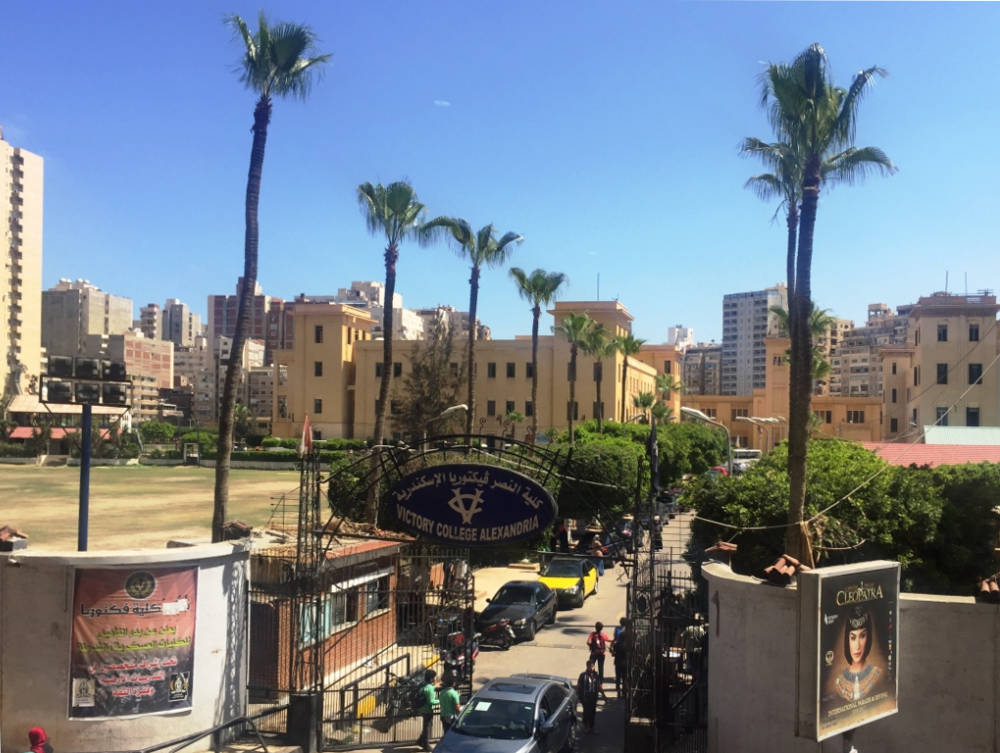We found Victoria College by chance. We were looking for the hospital where my grandmother had been a nurse in Egypt during the First World War. We had with us a 1918 postcard (see below) which she had kept showing a banner “No 17 British General Hospital” and a group of Australian soldiers standing by the front gate. I showed the picture to some Alexandria taxi drivers but nobody recognised the place. In browsing a photographic exhibition at the iconic Alexandria Library I spotted the unusual tower with three vertical slits (visible just to the right of the banner in the 1918 postcard). The title beneath the photograph read “Victoria College”.

No. 17 British General Hospital [Click on images to enlarge them.]
A taxi took us to the Ramleh district of Alexandria and there was the building, practically unchanged but now renamed “Victory College”. The following day the Headmistress arranged a visit and I managed to take a photograph from almost the same angle as in 1918. To the far left of the picture is a typical English cricket pavilion indicating that this must have been a school either for expatriate British children or for the Egyptian elite, similar to institutions in British India such as the Doon School at Dehra Dun, Bishop Cotton’s in Simla, Aitchison’s in Lahore, Mayo College in Ajmer, and the various Lawrence Colleges in Wellington, Sanawar and Murree. All these schools still survive with cricket as a key sport. In Alexandria the teachers denied all knowledge of cricket and claimed the pavilion was merely a sports centre. Another puzzling feature was that they did not know that Victory College had ever been Victoria College.

Victoria College now renamed Victory College.
Back at our hotel I soon uncovered the history of this remarkable institution thanks to an article by Samir Raafat published in the Egyptian Mail on 30th March 1996. I have included a link to this piece below in the bibliography.
The College was named after the great Queen who had died the year before its foundation by Lord Cromer, the Consul General, in 1902. The British had been the de facto rulers of Egypt since 1882. From the outset it was a remarkably cosmopolitan institution. As Raafat notes “If in 1902-3 there were only 45 students enrolled, by 1906 they had increased more than threefold to 186. They included 13 nationalities broken down into three religious groups; there were 80 Christians, 67 Jews and 39 Muslims, mirroring the city's upper-class mosaic. The school's motto was "Cuncti gens una sumus," meaning "Joined together as one people.”
Given the diversity of the pupils there was no organised religious practice at the school. Like an English public school the boys were divided into “houses” named after imperial notables; Cromer, Kitchener, Lloyd, Reed, Barker, Frobisher and Drake. The premises were designed and built by Henry Gorra, the Egyptian architect who also built the Hotel Majestic which still stands in central Alexandria. As in English public schools “outdoor sports were regarded as an important source of discipline and character formation - hence football, hockey and cricket, in which both masters and students took part” (Raafat). I was pleased to see the reference to cricket.
The First World War intervened and the site was commandeered for the 17th British Military Hospital which received vast numbers of wounded from the shores of Gallipoli and later from the campaign in Palestine, whence my grandfather was wounded and shipped to Alexandria for recovery; and later to woo and eventually marry his nurse. The school was again requisitioned as a hospital for the duration of the Second World War.
By 1934 there were 350 students and the first of many admissions to Oxford University. There were pupils from royal and noble families of Europe and the Middle East; Romanovs, Saxe-Coburgs, Zogs (of Albania), Hashemites, and al-Sharifs. There were also children of merchants, bankers, artists, academics and industrialists. By 1946, with nationalism on the rise, the British associations of Victoria College were becoming a problem for children and parents alike. The Suez invasion of 1956 was the final straw and all the British staff were deported. Victoria College was replaced by Victory College, a very different type of institution, with no use for cricket.


Osborne House, Isle of Wight, by Thomas Cubitt with Prince Albert. Right: .
Later, back in England, we noticed some architectural similarities with Osborne House, Queen Victoria’s residence on the Isle of Wight, particularly the square towers with vertical splits. Perhaps Henry Gorra took some of his inspiration from Sir Thomas Cubitt.
Photographs of Alexandria by the author. Photographs of Osborne House by — Jacqueline Banerjee. You may use these images without prior permission for any scholarly or educational purpose as long as you (1) credit the photographer and (2) link your document to this URL in a web document or cite the Victorian Web in a print one.
Bibliography
Rafaat, Samir. “Victoria College. Educating the elite 1902-1956.” egy.com. (Online version of an article that orginally appeared in the Egyptian Mail. 30 March 1996.
Last modified 3 August 2020